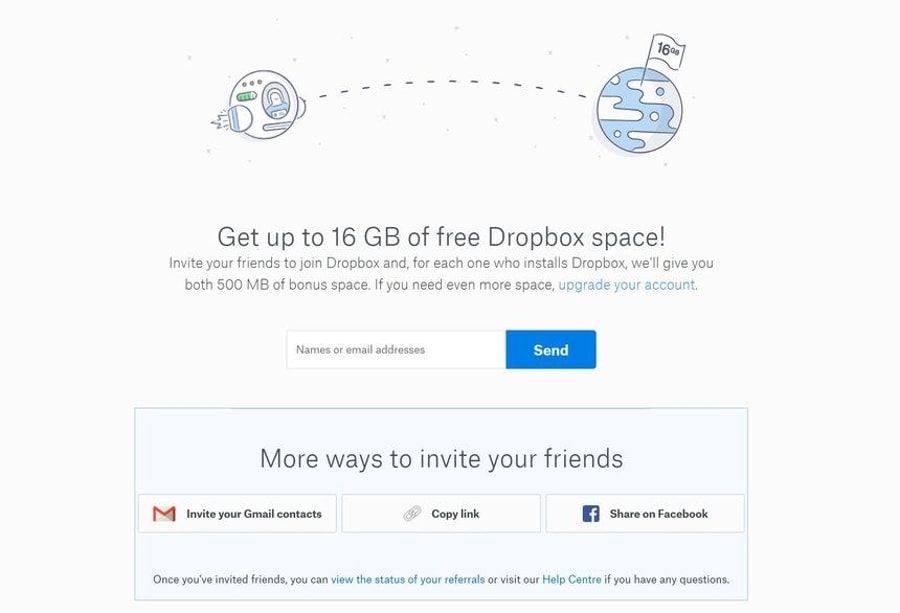Despite its potential, referral marketing is yet to achieve the same publicity as other growth strategies like content and influencer marketing. But as a widely acclaimed and low-cost acquisition channel, it’s bound to take centre-stage sometime soon.
Personal recommendations remain the oldest and most-trusted form of advertising, and the most influential as they’re the most likely to lead to some form of action being taken. This alone demonstrates just how much power referral marketing has, if done well.
This article explores the different types of referral marketing strategies, some examples of businesses that have done it well, and some straightforward tips on launching your own successful "refer a friend" campaign.
What is referral marketing?
Referral marketing is essentially people purchasing products based on someone else’s opinion or influence and is commonly known as word-of-mouth marketing. As a small business owner, this strategy is an effective way to get existing customers and friends to promote your business for you.
Referral marketing provides razor-sharp targeting as referral-based customers tend to be better matched to your services or products. This is because your existing customers will usually only promote services to their friends and family that they believe would be interested. They know their connection’s interests and preferences more than any business ever could and, consequently, it leads to better qualified leads and higher returns at a lower cost.
Different types of referral channels
Referral channels no longer end at friends and family. Since the rise of social media, social influencers act as a legitimate type of referral channel too — as long as the receiver trusts them, it counts.
Here are the most common referral channels:
- Friends/Family
- News Publications
- Customer Reviews
- Testimonials/Case Studies
- Opinions Posted Online (Forums)
- Influencer Opinions (Bloggers, Social Media Influencers)
Referral marketing done well
Now we’ve all agreed that referral marketing has huge potential for small businesses, let’s look at a couple of examples of companies that have used referral marketing strategies to grow their audience successfully.
Example One: Dropbox
It’s fair to say that the rapid growth of Dropbox, a personal cloud storage service, would’ve been significantly slower had it not been for the widespread success of their referral program, which catapulted the business from 100,000 sign-ups to four million in just 15 months.

So why was it so successful?
Dropbox offered dual-sided rewards, giving extra storage space to both the referrer and the referral recipient. This was clever for two reasons. Not only would their advocates feel better approaching their contacts as there was something in it for the recipient, but they were also getting users to invest in the product by offering an upgrade feature as the reward.
Of course, there were finer details of the campaign that contributed to its overall success, but getting the reward offering right was vital to the campaign playing out as it did.
Example Two: Gousto
Since launching in 2012 and appearing on Dragons Den in 2013, British meal kit retailer Gousto has grown expediently, now shifting over 400,000 meals per month. While the company has spread its net over a number of marketing channels with a clear focus on social media, they made a smart choice integrating a referral marketing strategy into their onboarding process from the very start.
As a Gousto customer, I’ve been exposed to their referral marketing campaigns and I’ve referred friends to use their services and been rewarded accordingly. I’ve done so because they made it extremely easy and I loved the experience so much that I knew certain friends of mine would love it too.

Gousto currently offer £15 credit towards the referrer’s next box and 50% off the referral recipient’s first two boxes, plus they’ll enter the referrer into a prize draw to win a years supply of wine. This is another successful example of dual-sided rewards, however they have customised the referrer and referral recipient’s rewards so each benefit in a different way. This is most likely down to the fact that they know they can demand a higher price from someone who has already experienced their product.
The main takeaway from Gousto’s referral set up is the seamless integration, making the process easy for anyone thinking of referring. They’ve made referring easy and accessible with a dashboard on the member account named ‘Free Food’, where users are provided with unique, trackable links to share.
Tips on launching a successful referral strategy
Implementing your own strategy to increase referrals can feel daunting, but it isn’t as difficult as it might seem. Here are some simple tips on getting it right.
1. Make sure you have the right foundations
At the core of any type of advocacy is an exceptional experience. People will only share and recommend your services if they think they’re worth shouting about. No matter what offer you push out, if the experience isn’t up to scratch no-one is going to participate.
Therefore, before you do anything, look at your business from a customer perspective and ask yourself whether it’s worth sharing with your friends. If the answer is no, then you have some changes to make before you launch your referral campaign.
2. Make sure your customers know about it
As with any offer, if your customer isn’t aware of it, they won’t take it up. Make it visible by either integrating widgets into your on-boarding process, adding a link to the offer somewhere prominent on your website and adding a dashboard within the customers online account.
A useful exercise might be to mystery shop your business, screenshot pages as you go (if it’s a purely online experience) and marking natural places where you could ask for a review or where you can promote the referral scheme.
3. Make it ridiculously easy for customers to refer your brand
It’s crucial to make it as easy as possible to share your products and refer your brand. There are several ways to do this, but one of the simplest tactics is to pre-populate social messages so the customer can share your offer in the click of a button.
Other methods include offering them a unique link so they can place it on a blog or website, as well as providing them with an email template to send out to friends in case this is their preference.
4. Make it visually shareable
With the rise of photo-sharing platforms like Instagram, more people are sharing their ‘unboxing’ experiences and images of your products on their social accounts because they’re visually impressed with your brand. Make sure your brand stands out from the crowd and add personalization where possible.
Consider your packaging and unboxing experience, if this is applicable to your business. Alternatively, if your service is purely online then you should consider how you could make your welcome email stand out from the crowd, or their first visit to their account positively memorable.
5. Capitalise on existing referrals
You may already receive qualified referrals that you don’t even know about.
Google Analytics offers a whole section on referral traffic sources, so if you can see a site is already referring quality traffic to you, it may be worth seeing if you can get some more. Perhaps write a guest blog for them or sign them up to your referral program and agree a revenue share for any new customers they bring your way.
6. Implement a referral program
In a perfect world, you’d want your referral campaign to sit neatly within your on-boarding process, run itself and require zero development — this is where referral software comes in handy.
If you don’t have the luxury of an in-house development team, I’d recommend trialing a referral program platform. They provide structure for your program and will guide you through the set up step-by-step. Ultimately, they want the campaign to work for you, otherwise you’ll be free to cancel your plan with them.
There are lots of really good platforms out there but deciding on which referral tool is right for your business depends heavily on what you do and your website platform. I’d recommend contacting a few and seeing which platform best suits your requirements.
7. Split test your offers
Believe it or not, this can be a critical factor as to whether a referral campaign works, in terms of the offer and how you communicate it.
Most of the referral program tools out there will allow you to split test, but as a general rule, when you write your offer copy focus on the benefit for the referrer not the referee, as it’s them that will need to take action.
For example, Dropbox positioned their offer as “Get more free space”, not “Invite friends”, as it offered more value to the referrer.






These cookies are set by a range of social media services that we have added to the site to enable you to share our content with your friends and networks. They are capable of tracking your browser across other sites and building up a profile of your interests. This may impact the content and messages you see on other websites you visit.
If you do not allow these cookies you may not be able to use or see these sharing tools.